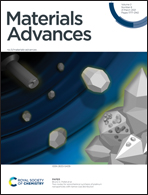An ultra-lithiophilic oxidation layer in a Ni-foam-based anode for lithium metal batteries†
Abstract
High-energy-density rechargeable batteries have been gaining considerable importance in the field of renewable energy, and Li-infused anodes are potential candidates for the development of such batteries. However, the poor cycling and dimensional stability of Li affects their performance. As most materials used in battery manufacturing are lithiophobic to molten Li, infusion of Li into the porous structures with an intrinsically lithiophobic surface presents challenges in the development of Li batteries. Optimising and improving the wettability of molten Li is one approach to address this. Herein, we propose a very practical and straightforward oxidation method for achieving an ultra-lithiophilic NiO layer on the surface of a three-dimensional Ni-foam. Oxidation of the Ni-foam in air resulted in a remarkable increase in the wettability of molten Li on the Ni surface, with a decrease in the wetting angle from 120° to 0°. A NiO layer was epitaxially grown on the surface of the Ni-foam, with a thickness of several hundreds of nanometres. This layer was lithiophilic and showed high electrical conductivity. An anode prepared using Li-infused oxidised Ni-foam showed no evidence of short circuits or dendrite formation after 1000 cycles of stripping and plating at 0.1 and 0.5 mA cm−2, whereas a pure Li anode showed unstable stripping and plating behaviour at 0.5 mA cm−2. The proposed surface-treatment method is considered the most simple and practical method among those reported to date, and the Ni-foam produced using this method showed excellent anode performance. Hence, the proposed method will facilitate further development of rechargeable lithium-metal battery technology.



 Please wait while we load your content...
Please wait while we load your content...